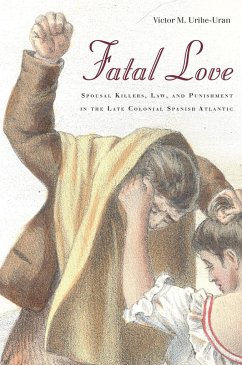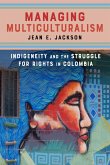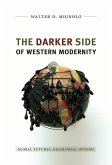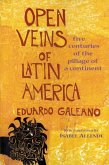Victor M. Uribe-Uran
Fatal Love
Spousal Killers, Law, and Punishment in the Late Colonial Spanish Atlantic
Victor M. Uribe-Uran
Fatal Love
Spousal Killers, Law, and Punishment in the Late Colonial Spanish Atlantic
- Gebundenes Buch
- Merkliste
- Auf die Merkliste
- Bewerten Bewerten
- Teilen
- Produkt teilen
- Produkterinnerung
- Produkterinnerung
Victor M. Uribe-Uran is Associate Professor of History and of Law at Florida International University. He is the author of Honorable Lives: Lawyers, Family, and Politics in Colombia, 1780¿1850 and the editor of State and Society in Spanish America during the Age of Revolution.
Andere Kunden interessierten sich auch für
![Managing Multiculturalism Managing Multiculturalism]() Jean E. JacksonManaging Multiculturalism153,99 €
Jean E. JacksonManaging Multiculturalism153,99 €![Death in Old Mexico Death in Old Mexico]() Nicole von Germeten (Oregon State University)Death in Old Mexico33,99 €
Nicole von Germeten (Oregon State University)Death in Old Mexico33,99 €![The Darker Side of Western Modernity The Darker Side of Western Modernity]() Walter D. MignoloThe Darker Side of Western Modernity35,99 €
Walter D. MignoloThe Darker Side of Western Modernity35,99 €![Territories of Difference Territories of Difference]() Arturo EscobarTerritories of Difference35,99 €
Arturo EscobarTerritories of Difference35,99 €![The Essential Neruda The Essential Neruda]() Pablo NerudaThe Essential Neruda11,99 €
Pablo NerudaThe Essential Neruda11,99 €![Open Veins of Latin America Open Veins of Latin America]() Eduardo GaleanoOpen Veins of Latin America20,99 €
Eduardo GaleanoOpen Veins of Latin America20,99 €![The Penguin History Of Latin America The Penguin History Of Latin America]() Edwin WilliamsonThe Penguin History Of Latin America20,99 €
Edwin WilliamsonThe Penguin History Of Latin America20,99 €-
-
-
Victor M. Uribe-Uran is Associate Professor of History and of Law at Florida International University. He is the author of Honorable Lives: Lawyers, Family, and Politics in Colombia, 1780¿1850 and the editor of State and Society in Spanish America during the Age of Revolution.
Hinweis: Dieser Artikel kann nur an eine deutsche Lieferadresse ausgeliefert werden.
Hinweis: Dieser Artikel kann nur an eine deutsche Lieferadresse ausgeliefert werden.
Produktdetails
- Produktdetails
- Verlag: Stanford University Press
- Seitenzahl: 456
- Erscheinungstermin: 16. Dezember 2015
- Englisch
- Abmessung: 229mm x 155mm x 28mm
- Gewicht: 800g
- ISBN-13: 9780804794633
- ISBN-10: 0804794634
- Artikelnr.: 42786790
- Herstellerkennzeichnung
- Libri GmbH
- Europaallee 1
- 36244 Bad Hersfeld
- gpsr@libri.de
- Verlag: Stanford University Press
- Seitenzahl: 456
- Erscheinungstermin: 16. Dezember 2015
- Englisch
- Abmessung: 229mm x 155mm x 28mm
- Gewicht: 800g
- ISBN-13: 9780804794633
- ISBN-10: 0804794634
- Artikelnr.: 42786790
- Herstellerkennzeichnung
- Libri GmbH
- Europaallee 1
- 36244 Bad Hersfeld
- gpsr@libri.de
Victor M. Uribe-Uran is Associate Professor of History and of Law at Florida International University. He is the author of Honorable Lives: Lawyers, Family, and Politics in Colombia, 1780-1850 and the editor of State and Society in Spanish America during the Age of Revolution.
Contents and Abstracts
Introduction
chapter abstract
Addresses historiographical and theoretical issues, discussing the
literatures on domestic violence, crime, in particular homicide, and legal
history. It proposes that this study bridges the worlds of social and legal
history and contributes to historiographical debates concerning the reasons
behind the alleged gap between law and reality, the doctrinal roots
regarding leniency towards Indians, the extent to which women remained
restricted to the domestic sphere, and the functioning of masculine honor.
Finally, it describes the study's sources, methodology and time period,
highlighting their significance.
1Access to Justice: Domestic Violence, Laws and Procedures
chapter abstract
Looks at canon or ecclesiastical and civil laws pertaining to marriage and
marriage-related crimes in Spain and those in the colonies, and examines
judicial procedures concerning the trial of public crimes. The chapter
establishes that access to justice and knowledge of legal procedures was
widespread and central to the legitimation of the monarchy.
2Innocent Infants? Indians and Domestic Violence in Colonial Mexico.
chapter abstract
Focuses on 87 cases of spousal murder taking place in late colonial Mexico.
In addition to shedding light on the circumstances and motives of the
crimes, the discussion centers on the ethnic dimensions of the murders in
question, a majority of which were committed by members of the indigenous
community.
3The King's Forgiveness: Earthly Intercessions and Legal Culture
chapter abstract
Looks at excuses murderers could use to reduce their sentences, in
particular those derived from drinking and other mitigating factors. It
examines also the favorable treatment granted to Indians, and the extensive
use of royal pardons. The chapter argues that forgiveness was essential to
the image and legitimacy of the Spanish monarchy and strategic to its
hegemonic control over society.
4Honor and Punishment in Late Eighteenth-Century Spain
chapter abstract
Focuses on over 65 murders committed by Spanish wives and husbands,
detailing their characteristics. Given the saliency of murders committed by
unfaithful wives, this chapter explores the culture of honor and the extent
to which it could be considered central to explaining the events under
consideration. It demonstrates that most incidents resulting from
extramarital affairs involved women who killed their husbands, not the
other way around. This suggests that the honor codes were upended.
5God's Forgiveness: Heavenly Intercessions
chapter abstract
Examines legal mechanisms whereby the Catholic church sheltered spousal
murderers and other criminals and the King acted as God's proxy to extend
pardon to criminals during the Catholic Holy Week. It also shows the
central role of the church in the alleviation of punishment and the
accompaniment of those marching to the gallows. It establishes that
forgiveness was thus also critical to the legitimacy of the Church and its
hegemony, both a complementary and competing force relative to the
monarchy.
6Dangerous Women: Gender and Domestic Disputes in Colonial Colombia
chapter abstract
Examines 54 cases of spousal murder that took place in late colonial
Colombia. Similar to the discussion on Mexico, this chapter addresses the
circumstances and motives of the crimes. Rather than concentrating on the
ethic aspects of the various crimes, however, it highlights the gender
dimensions. This is important in light of the fact that a considerable
portion of the murders were committed by women, a peculiar situation the
chapter seeks to understand.
7The Many Shades of Pain and Punishment in the Spanish Atlantic
chapter abstract
Turns attention to punishments by considering encubamiento and confinement,
the decline of judicial torture, and harshness against mixed-races. It
shows the overall decline of the death penalty, the fact that it impacted
much more metropolitan than colonial subjects and whites that non-whites,
while establishing also the significance of other forms of punishment in
particular confinement. It confirms too the great significance of clemency.
8Transition to Independence, Criminal Justice and the Reinvention of
Hegemony and Coercion in the Spanish Atlantic
chapter abstract
Examines briefly some of the changes brought about by Independence and
peninsular liberalism. It establishes that the humanization of punishment
was not the abrupt result of independence and liberalism but a long-term
("developmental") process extending back to even the 16th century
Conclusion
chapter abstract
Reiterates the centrality of law and justice in the lives of late colonial
Spanish Atlantic couples, even members of Indigenous communities and
colored peoples. It summarizes the study's findings about ethnic, gender
and other cultural relations. Highlights, in particular, the apparent
upending of stereotypes on negative legal discrimination against the
natives; the exclusion of women from public life; and, the alleged male
proclivity to avenge honor besmirched by morally inappropriate sexual
behavior on the part of female companions. Stresses too hegemony at work,
through the observance of longstanding legal rules, judicial routines,
ceremonies and habitus concerning appropriate individual, familial and
social behavior, as well as the right behavior on the part of Crown and
Church, during times of peace and conflict.
Introduction
chapter abstract
Addresses historiographical and theoretical issues, discussing the
literatures on domestic violence, crime, in particular homicide, and legal
history. It proposes that this study bridges the worlds of social and legal
history and contributes to historiographical debates concerning the reasons
behind the alleged gap between law and reality, the doctrinal roots
regarding leniency towards Indians, the extent to which women remained
restricted to the domestic sphere, and the functioning of masculine honor.
Finally, it describes the study's sources, methodology and time period,
highlighting their significance.
1Access to Justice: Domestic Violence, Laws and Procedures
chapter abstract
Looks at canon or ecclesiastical and civil laws pertaining to marriage and
marriage-related crimes in Spain and those in the colonies, and examines
judicial procedures concerning the trial of public crimes. The chapter
establishes that access to justice and knowledge of legal procedures was
widespread and central to the legitimation of the monarchy.
2Innocent Infants? Indians and Domestic Violence in Colonial Mexico.
chapter abstract
Focuses on 87 cases of spousal murder taking place in late colonial Mexico.
In addition to shedding light on the circumstances and motives of the
crimes, the discussion centers on the ethnic dimensions of the murders in
question, a majority of which were committed by members of the indigenous
community.
3The King's Forgiveness: Earthly Intercessions and Legal Culture
chapter abstract
Looks at excuses murderers could use to reduce their sentences, in
particular those derived from drinking and other mitigating factors. It
examines also the favorable treatment granted to Indians, and the extensive
use of royal pardons. The chapter argues that forgiveness was essential to
the image and legitimacy of the Spanish monarchy and strategic to its
hegemonic control over society.
4Honor and Punishment in Late Eighteenth-Century Spain
chapter abstract
Focuses on over 65 murders committed by Spanish wives and husbands,
detailing their characteristics. Given the saliency of murders committed by
unfaithful wives, this chapter explores the culture of honor and the extent
to which it could be considered central to explaining the events under
consideration. It demonstrates that most incidents resulting from
extramarital affairs involved women who killed their husbands, not the
other way around. This suggests that the honor codes were upended.
5God's Forgiveness: Heavenly Intercessions
chapter abstract
Examines legal mechanisms whereby the Catholic church sheltered spousal
murderers and other criminals and the King acted as God's proxy to extend
pardon to criminals during the Catholic Holy Week. It also shows the
central role of the church in the alleviation of punishment and the
accompaniment of those marching to the gallows. It establishes that
forgiveness was thus also critical to the legitimacy of the Church and its
hegemony, both a complementary and competing force relative to the
monarchy.
6Dangerous Women: Gender and Domestic Disputes in Colonial Colombia
chapter abstract
Examines 54 cases of spousal murder that took place in late colonial
Colombia. Similar to the discussion on Mexico, this chapter addresses the
circumstances and motives of the crimes. Rather than concentrating on the
ethic aspects of the various crimes, however, it highlights the gender
dimensions. This is important in light of the fact that a considerable
portion of the murders were committed by women, a peculiar situation the
chapter seeks to understand.
7The Many Shades of Pain and Punishment in the Spanish Atlantic
chapter abstract
Turns attention to punishments by considering encubamiento and confinement,
the decline of judicial torture, and harshness against mixed-races. It
shows the overall decline of the death penalty, the fact that it impacted
much more metropolitan than colonial subjects and whites that non-whites,
while establishing also the significance of other forms of punishment in
particular confinement. It confirms too the great significance of clemency.
8Transition to Independence, Criminal Justice and the Reinvention of
Hegemony and Coercion in the Spanish Atlantic
chapter abstract
Examines briefly some of the changes brought about by Independence and
peninsular liberalism. It establishes that the humanization of punishment
was not the abrupt result of independence and liberalism but a long-term
("developmental") process extending back to even the 16th century
Conclusion
chapter abstract
Reiterates the centrality of law and justice in the lives of late colonial
Spanish Atlantic couples, even members of Indigenous communities and
colored peoples. It summarizes the study's findings about ethnic, gender
and other cultural relations. Highlights, in particular, the apparent
upending of stereotypes on negative legal discrimination against the
natives; the exclusion of women from public life; and, the alleged male
proclivity to avenge honor besmirched by morally inappropriate sexual
behavior on the part of female companions. Stresses too hegemony at work,
through the observance of longstanding legal rules, judicial routines,
ceremonies and habitus concerning appropriate individual, familial and
social behavior, as well as the right behavior on the part of Crown and
Church, during times of peace and conflict.
Contents and Abstracts
Introduction
chapter abstract
Addresses historiographical and theoretical issues, discussing the
literatures on domestic violence, crime, in particular homicide, and legal
history. It proposes that this study bridges the worlds of social and legal
history and contributes to historiographical debates concerning the reasons
behind the alleged gap between law and reality, the doctrinal roots
regarding leniency towards Indians, the extent to which women remained
restricted to the domestic sphere, and the functioning of masculine honor.
Finally, it describes the study's sources, methodology and time period,
highlighting their significance.
1Access to Justice: Domestic Violence, Laws and Procedures
chapter abstract
Looks at canon or ecclesiastical and civil laws pertaining to marriage and
marriage-related crimes in Spain and those in the colonies, and examines
judicial procedures concerning the trial of public crimes. The chapter
establishes that access to justice and knowledge of legal procedures was
widespread and central to the legitimation of the monarchy.
2Innocent Infants? Indians and Domestic Violence in Colonial Mexico.
chapter abstract
Focuses on 87 cases of spousal murder taking place in late colonial Mexico.
In addition to shedding light on the circumstances and motives of the
crimes, the discussion centers on the ethnic dimensions of the murders in
question, a majority of which were committed by members of the indigenous
community.
3The King's Forgiveness: Earthly Intercessions and Legal Culture
chapter abstract
Looks at excuses murderers could use to reduce their sentences, in
particular those derived from drinking and other mitigating factors. It
examines also the favorable treatment granted to Indians, and the extensive
use of royal pardons. The chapter argues that forgiveness was essential to
the image and legitimacy of the Spanish monarchy and strategic to its
hegemonic control over society.
4Honor and Punishment in Late Eighteenth-Century Spain
chapter abstract
Focuses on over 65 murders committed by Spanish wives and husbands,
detailing their characteristics. Given the saliency of murders committed by
unfaithful wives, this chapter explores the culture of honor and the extent
to which it could be considered central to explaining the events under
consideration. It demonstrates that most incidents resulting from
extramarital affairs involved women who killed their husbands, not the
other way around. This suggests that the honor codes were upended.
5God's Forgiveness: Heavenly Intercessions
chapter abstract
Examines legal mechanisms whereby the Catholic church sheltered spousal
murderers and other criminals and the King acted as God's proxy to extend
pardon to criminals during the Catholic Holy Week. It also shows the
central role of the church in the alleviation of punishment and the
accompaniment of those marching to the gallows. It establishes that
forgiveness was thus also critical to the legitimacy of the Church and its
hegemony, both a complementary and competing force relative to the
monarchy.
6Dangerous Women: Gender and Domestic Disputes in Colonial Colombia
chapter abstract
Examines 54 cases of spousal murder that took place in late colonial
Colombia. Similar to the discussion on Mexico, this chapter addresses the
circumstances and motives of the crimes. Rather than concentrating on the
ethic aspects of the various crimes, however, it highlights the gender
dimensions. This is important in light of the fact that a considerable
portion of the murders were committed by women, a peculiar situation the
chapter seeks to understand.
7The Many Shades of Pain and Punishment in the Spanish Atlantic
chapter abstract
Turns attention to punishments by considering encubamiento and confinement,
the decline of judicial torture, and harshness against mixed-races. It
shows the overall decline of the death penalty, the fact that it impacted
much more metropolitan than colonial subjects and whites that non-whites,
while establishing also the significance of other forms of punishment in
particular confinement. It confirms too the great significance of clemency.
8Transition to Independence, Criminal Justice and the Reinvention of
Hegemony and Coercion in the Spanish Atlantic
chapter abstract
Examines briefly some of the changes brought about by Independence and
peninsular liberalism. It establishes that the humanization of punishment
was not the abrupt result of independence and liberalism but a long-term
("developmental") process extending back to even the 16th century
Conclusion
chapter abstract
Reiterates the centrality of law and justice in the lives of late colonial
Spanish Atlantic couples, even members of Indigenous communities and
colored peoples. It summarizes the study's findings about ethnic, gender
and other cultural relations. Highlights, in particular, the apparent
upending of stereotypes on negative legal discrimination against the
natives; the exclusion of women from public life; and, the alleged male
proclivity to avenge honor besmirched by morally inappropriate sexual
behavior on the part of female companions. Stresses too hegemony at work,
through the observance of longstanding legal rules, judicial routines,
ceremonies and habitus concerning appropriate individual, familial and
social behavior, as well as the right behavior on the part of Crown and
Church, during times of peace and conflict.
Introduction
chapter abstract
Addresses historiographical and theoretical issues, discussing the
literatures on domestic violence, crime, in particular homicide, and legal
history. It proposes that this study bridges the worlds of social and legal
history and contributes to historiographical debates concerning the reasons
behind the alleged gap between law and reality, the doctrinal roots
regarding leniency towards Indians, the extent to which women remained
restricted to the domestic sphere, and the functioning of masculine honor.
Finally, it describes the study's sources, methodology and time period,
highlighting their significance.
1Access to Justice: Domestic Violence, Laws and Procedures
chapter abstract
Looks at canon or ecclesiastical and civil laws pertaining to marriage and
marriage-related crimes in Spain and those in the colonies, and examines
judicial procedures concerning the trial of public crimes. The chapter
establishes that access to justice and knowledge of legal procedures was
widespread and central to the legitimation of the monarchy.
2Innocent Infants? Indians and Domestic Violence in Colonial Mexico.
chapter abstract
Focuses on 87 cases of spousal murder taking place in late colonial Mexico.
In addition to shedding light on the circumstances and motives of the
crimes, the discussion centers on the ethnic dimensions of the murders in
question, a majority of which were committed by members of the indigenous
community.
3The King's Forgiveness: Earthly Intercessions and Legal Culture
chapter abstract
Looks at excuses murderers could use to reduce their sentences, in
particular those derived from drinking and other mitigating factors. It
examines also the favorable treatment granted to Indians, and the extensive
use of royal pardons. The chapter argues that forgiveness was essential to
the image and legitimacy of the Spanish monarchy and strategic to its
hegemonic control over society.
4Honor and Punishment in Late Eighteenth-Century Spain
chapter abstract
Focuses on over 65 murders committed by Spanish wives and husbands,
detailing their characteristics. Given the saliency of murders committed by
unfaithful wives, this chapter explores the culture of honor and the extent
to which it could be considered central to explaining the events under
consideration. It demonstrates that most incidents resulting from
extramarital affairs involved women who killed their husbands, not the
other way around. This suggests that the honor codes were upended.
5God's Forgiveness: Heavenly Intercessions
chapter abstract
Examines legal mechanisms whereby the Catholic church sheltered spousal
murderers and other criminals and the King acted as God's proxy to extend
pardon to criminals during the Catholic Holy Week. It also shows the
central role of the church in the alleviation of punishment and the
accompaniment of those marching to the gallows. It establishes that
forgiveness was thus also critical to the legitimacy of the Church and its
hegemony, both a complementary and competing force relative to the
monarchy.
6Dangerous Women: Gender and Domestic Disputes in Colonial Colombia
chapter abstract
Examines 54 cases of spousal murder that took place in late colonial
Colombia. Similar to the discussion on Mexico, this chapter addresses the
circumstances and motives of the crimes. Rather than concentrating on the
ethic aspects of the various crimes, however, it highlights the gender
dimensions. This is important in light of the fact that a considerable
portion of the murders were committed by women, a peculiar situation the
chapter seeks to understand.
7The Many Shades of Pain and Punishment in the Spanish Atlantic
chapter abstract
Turns attention to punishments by considering encubamiento and confinement,
the decline of judicial torture, and harshness against mixed-races. It
shows the overall decline of the death penalty, the fact that it impacted
much more metropolitan than colonial subjects and whites that non-whites,
while establishing also the significance of other forms of punishment in
particular confinement. It confirms too the great significance of clemency.
8Transition to Independence, Criminal Justice and the Reinvention of
Hegemony and Coercion in the Spanish Atlantic
chapter abstract
Examines briefly some of the changes brought about by Independence and
peninsular liberalism. It establishes that the humanization of punishment
was not the abrupt result of independence and liberalism but a long-term
("developmental") process extending back to even the 16th century
Conclusion
chapter abstract
Reiterates the centrality of law and justice in the lives of late colonial
Spanish Atlantic couples, even members of Indigenous communities and
colored peoples. It summarizes the study's findings about ethnic, gender
and other cultural relations. Highlights, in particular, the apparent
upending of stereotypes on negative legal discrimination against the
natives; the exclusion of women from public life; and, the alleged male
proclivity to avenge honor besmirched by morally inappropriate sexual
behavior on the part of female companions. Stresses too hegemony at work,
through the observance of longstanding legal rules, judicial routines,
ceremonies and habitus concerning appropriate individual, familial and
social behavior, as well as the right behavior on the part of Crown and
Church, during times of peace and conflict.








